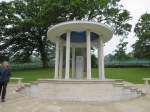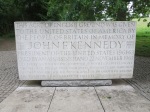On Saturday we joined a group of about twenty five of our friends to spend a leisurely day in the region of Windsor Great Park and Runnymede, exploring various monuments before the crowds descend for the 800th anniversary of the signing of the Magna Carta on June 15th.
 Our first stop was at the Air Forces Memorial at Englefield Green, where the names of all the airwomen and airmen of the British Empire who were killed in World War II – all 20,456 of them – are recorded, carved in stone. The monument was designed by Sir Edward Maufe, who was also the architect of Guildford Cathedral; and as I know that building extremely well, it was fascinating to see many of the same motifs and architectural vocabulary here as in that other building. A spiral staircase led up to the roof of the monument, from where we had stunning views down over the river, the reservoirs, Heathrow airport and even Windsor Castle.
Our first stop was at the Air Forces Memorial at Englefield Green, where the names of all the airwomen and airmen of the British Empire who were killed in World War II – all 20,456 of them – are recorded, carved in stone. The monument was designed by Sir Edward Maufe, who was also the architect of Guildford Cathedral; and as I know that building extremely well, it was fascinating to see many of the same motifs and architectural vocabulary here as in that other building. A spiral staircase led up to the roof of the monument, from where we had stunning views down over the river, the reservoirs, Heathrow airport and even Windsor Castle.

Our next stop was the Magna Carta Memorial itself – also designed by Maufe. The full name, Magna Carta Libertatum, gives a little more clue as to what it was all about. Sadly, though, no one took much notice of the original charter after it had been sealed, rather than signed, by the king; and it was repealed and reinstated several times through history. It didn’t really have much to do with democracy: it didn’t affect normal people, but just the relationship between the king and the barons. And yet we uphold it as some sort of founding document of our rights and liberties.
I think this is because it has become a symbol rather than an historical record. Although it didn’t really survive the vicissitudes of royal misbehaviour, or that of the aristocracy in the form of barons, much of what it signified has passed down to us in elements of, for instance, habeas corpus, the American constitution and our very ideas of what is a decent society. So, for instance, it established the fact that monarchs had to abide by the law as much as commoners, that miscreants should be tried by jury and that punishment should fit the crime.
We found ourselves whisked forward in time travel as inscribed into the stone were the words ‘This plaque was unveiled by HRH The Princess Royal, 15 June 2015’. As we were visiting on 13th June, we thought this solid assertion was a little premature, and we were left hoping that the princess did not suffer any mishaps between then and her appearance two days later.
Our final stop of historical importance was the John F Kennedy memorial. Here we entered the United States, as an acre of land was given by Britain to the US for a fitting memorial to their assassinated President. We climbed up the path through a peaceful glade to the memorial itself, which w as designed by Sir Geoffrey Jellicoe. Part of the inspiration for his work is said to have been Bunyan’s Pilgrim’s Progress, and the experience of climbing up to the monument had a contemplative feeling. I found myself reflecting, sadly, not only on that crazy death, but on so many other areas of violence and killing in the world today.
as designed by Sir Geoffrey Jellicoe. Part of the inspiration for his work is said to have been Bunyan’s Pilgrim’s Progress, and the experience of climbing up to the monument had a contemplative feeling. I found myself reflecting, sadly, not only on that crazy death, but on so many other areas of violence and killing in the world today.
In between these visits, we watched pleasure craft on the Thames, relaxed under a huge oak tree in a meadow for our picnic lunch and, of course, engaged in constant conversation and general merry-making.
3 Comments
